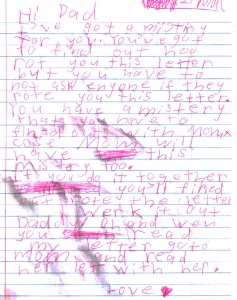Feb 10th, 2009 by Frank LaBanca, Ed.D.
 After dinner tonight, my older daughter Anna (6) said that my wife and I had mail, but she “didn’t know” who it was from. It contained a “mystery” that we needed to solve. Each of us had a different letter giving us clues to figure out who and where s(he) was. We found that she had scattered a breadcrumb trail made of index cards all around the house and it eventually led us to her room. She was so excited that we found her, but frankly, I am more excited to see what she had done.
After dinner tonight, my older daughter Anna (6) said that my wife and I had mail, but she “didn’t know” who it was from. It contained a “mystery” that we needed to solve. Each of us had a different letter giving us clues to figure out who and where s(he) was. We found that she had scattered a breadcrumb trail made of index cards all around the house and it eventually led us to her room. She was so excited that we found her, but frankly, I am more excited to see what she had done.
You see, Anna had created an piece of writing for a specific, authentic audience. She wasn’t writing within the confines of directed parameters of some adult, but rather what was interesting to her. She was certainly utilizing age-appropriate higher order thinking skills, connecting two independent writing samples purposefully, all with a goal of having two individuals work together. Of course there were spelling and grammar errors, but that is appropriate at this age. What was important was the conveyance of a novel idea.
 Anna was problem finding today, and in my mind, that is one of the most important creative acts in which an individual can engage. These are the things we need to promote in education in our young children. Sure we want them to solve problems, but I think we always must keep in the back of our minds, that the problems we ask children to solve are often well-defined: a well-known question, with well known answer. When we leave our comfort zone and push the boundaries of ill-defined questions and answers that we don’t necessarily develop or know the answers, we allow our children (students) to become more thoughtful, autonomous thinkers.
Anna was problem finding today, and in my mind, that is one of the most important creative acts in which an individual can engage. These are the things we need to promote in education in our young children. Sure we want them to solve problems, but I think we always must keep in the back of our minds, that the problems we ask children to solve are often well-defined: a well-known question, with well known answer. When we leave our comfort zone and push the boundaries of ill-defined questions and answers that we don’t necessarily develop or know the answers, we allow our children (students) to become more thoughtful, autonomous thinkers.
My students and I can certainly learn from Anna’s example.